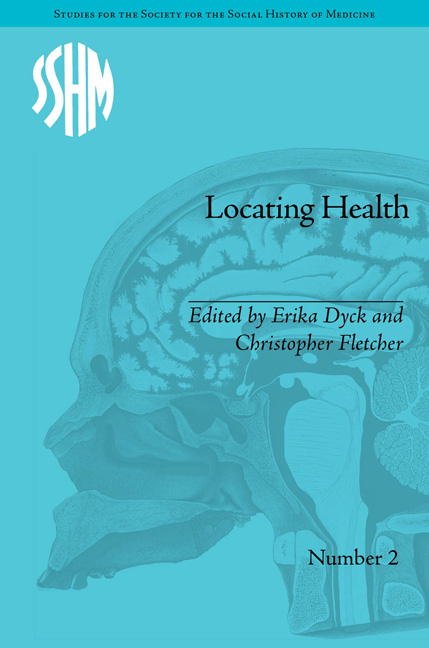Book contents
- Frontmatter
- CONTENTS
- List of Tables
- List of Contributors
- Acknowledgements and Preface
- Introduction: Healthscapes: Health and Place among and between Disciplines
- 1 Placing Maternal Health in India
- 2 Putting Medicine in its Place: The Importance of Historical Geography to the History of Health Care
- 3 Finding Place in The Big-Little World of Doc Pritham: Telling Medical Tales about Northwoods Maine, 1920s–70s
- 4 Putting Hyperactivity in its Place: Cold War Politics, the Brain Race and the Origins of Hyperactivity in the United States, 1957–68
- 5 Why Canada Has a Universal Medical Insurance Programme and the United States Does Not: Accounting for Historical Differences in American and Canadian Social Policies
- 6 Alberta Advantage: A Canadian Proving Ground for American Medical Research on Mustard Gas and Polio in the 1940s and 50s
- 7 Placing Illness in its Cultural Territory in Veracruz, Nicaragua
- 8 Chronic Disease in the Yukon River Basin, 1890–1960
- 9 An Ideal Home for the Consumptive: Place, Race and Tuberculosis in the Canadian West
- 10 Serbian Landscapes of Dreamtime and Healing: Clear Streams, Stones of Prophesy, St Sava's Ribs, and the Wooden City of Oz
- Notes
- Index
9 - An Ideal Home for the Consumptive: Place, Race and Tuberculosis in the Canadian West
- Frontmatter
- CONTENTS
- List of Tables
- List of Contributors
- Acknowledgements and Preface
- Introduction: Healthscapes: Health and Place among and between Disciplines
- 1 Placing Maternal Health in India
- 2 Putting Medicine in its Place: The Importance of Historical Geography to the History of Health Care
- 3 Finding Place in The Big-Little World of Doc Pritham: Telling Medical Tales about Northwoods Maine, 1920s–70s
- 4 Putting Hyperactivity in its Place: Cold War Politics, the Brain Race and the Origins of Hyperactivity in the United States, 1957–68
- 5 Why Canada Has a Universal Medical Insurance Programme and the United States Does Not: Accounting for Historical Differences in American and Canadian Social Policies
- 6 Alberta Advantage: A Canadian Proving Ground for American Medical Research on Mustard Gas and Polio in the 1940s and 50s
- 7 Placing Illness in its Cultural Territory in Veracruz, Nicaragua
- 8 Chronic Disease in the Yukon River Basin, 1890–1960
- 9 An Ideal Home for the Consumptive: Place, Race and Tuberculosis in the Canadian West
- 10 Serbian Landscapes of Dreamtime and Healing: Clear Streams, Stones of Prophesy, St Sava's Ribs, and the Wooden City of Oz
- Notes
- Index
Summary
In 1895 a group of prominent Calgary citizens extolled the advantages of their city as a site for a national tuberculosis sanatorium. The city, they boasted, was the ‘Denver of Canada’ and an ideal home for consumptives. Area physicians outlined the specific medical advantages of the region's climate, geography and elevation. Far removed from the congestion and foul air of Europe and eastern Canada the consumptive would benefit from the salubrious prairie west's clear bracing air and endless sunshine. Needless to say the national sanatorium was ultimately established in Ontario. The Calgarians were not, however, eager to attract all consumptives. The region's Aboriginal people, increasingly exposed to infection and to the repressive policies of the state, came to be seen as fundamentally deficient in their reaction to the disease. The Indian reserves served to isolate and contain both their disease and their poverty. Fifty years later, in 1945, hundreds of Edmonton residents publicly and loudly objected to the federal government's plans to establish a sanatorium in their city for Aboriginal people. They demanded that the government establish the sanatorium somewhere – anywhere – else. A spatial analysis of the shifting cultural and medical understandings of the disease, from consumption as a condition of the delicate and wealthy to tuberculosis as an infectious disease of the poor and the Aboriginal, highlights the roles of race and class in the construction of disease and its treatment.
- Type
- Chapter
- Information
- Locating HealthHistorical and Anthropological Investigations of Place and Health, pp. 151 - 168Publisher: Pickering & ChattoFirst published in: 2014



